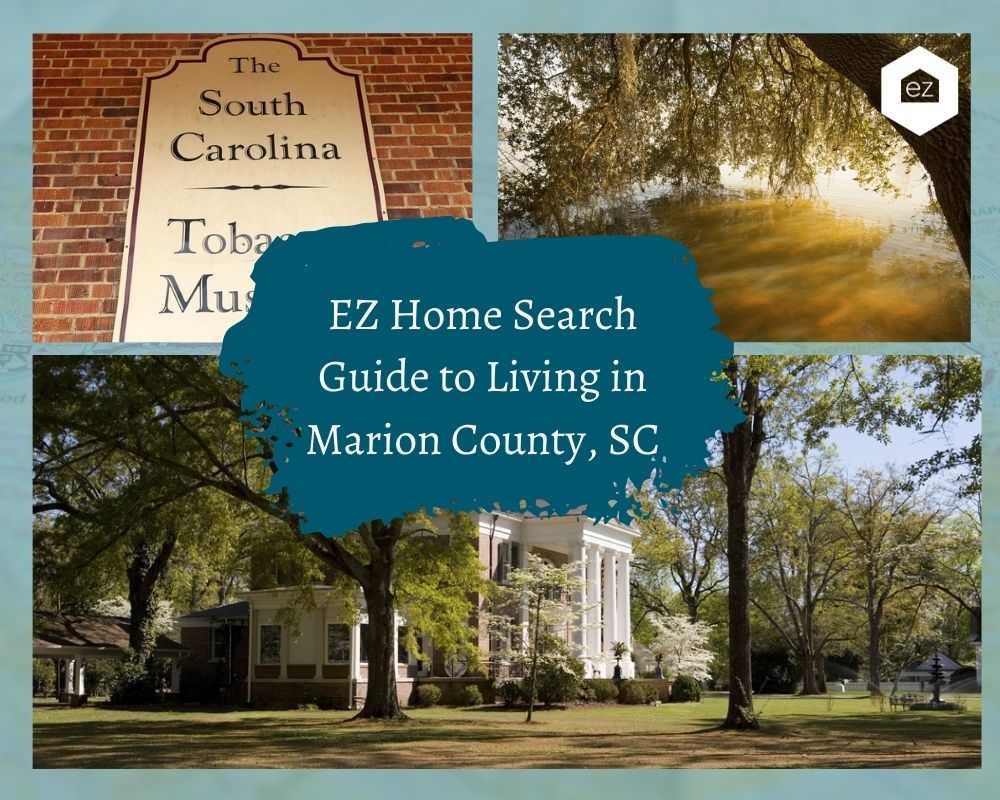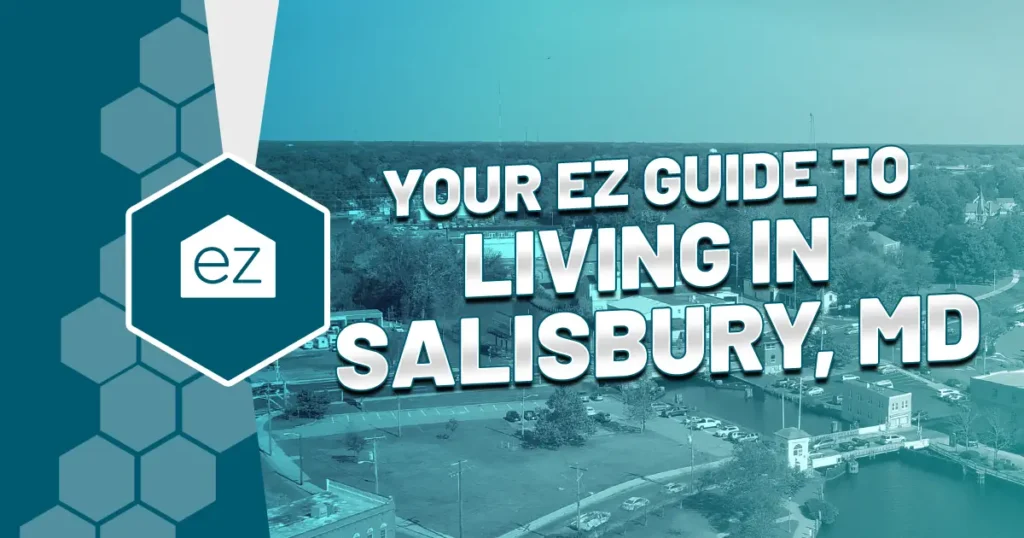EZ Home Search Guide to Living in Marion County, SC
EZ Home Search Guide to Living in Marion County, SC
If you are looking for a slower pace of life, abundant natural beauty, and a place where the neighbors know each other’s names, look to Marion County, South Carolina. This is a land wealthy with historical sites, rivers, forests, and close-knit communities. You’ll find real small-town values where people look after each other, say hello to each other on the streets, and show pride in their identity.
Take a look at why people come to Marion County and make it their home.
About Marion County
Located in the Lowcountry area of South Carolina, the area has a mild climate that makes outdoor recreation possible in all four seasons. The county’s total area is 494 square miles, making it one of the smaller counties in the state.
The borders are created by the Great Pee Dee River and the Little Pee Dee River. In addition, the county is cut through by Catfish Creek, Buck Swamp, Jordan Creek, Ten Mile Bay, and Maldendown Bay.
Marion County is surrounded by Dillon, Horry, Georgetown, Williamsburg, and Florence Counties. Its central location means residents are close to attractions like historic Georgetown and Myrtle Beach.
Its land has made Marion County an important agricultural provider for the surrounding communities. The region has an unusually level surface and large open fields numbering hundreds of acres. The topography makes farming relatively easy, and with the area’s climate providing regular rainfall, it’s easy to grow a variety of crops here. Cotton, tobacco, and corn are the principal crops grown in Marion County. With 240 growing days a year, it’s possible for farmers to grow two crops in a season.
Marion County and its forests historically have been essential providers of lumber. The year-round water supply makes it suitable to grow important trees like small gum and pine.
The cost of living in Marion County is also incredibly low. According to the 2020 Sperling’s Best Places cost of living index, where 100 represents the national median, Marion County’s living cost was 76.2. Nearby Charleston was 111.5, making it more expensive than the national median. Of note was the region’s housing cost, which was indexed at 38.6. It was also below average for transportation, food, and miscellaneous costs. Its cost for utilities and health care was only tenths of a point above the national median. All of that is to say the cost of living is extremely affordable if you’re looking for a place to live on a tight budget.
Marion County History
This region in South Carolina was first settled by the Pee Dee, Cheraw, and Waccamaw Indians, who influenced many of the area’s place names. These native peoples thrived on the resources provided by the area’s rivers. The same rivers provided European settlers with access to the South Carolina interior. By the late 1700s, the area’s earliest communities were founded, such as Marion, Nichols, and Mullins.
The region was originally part of Craven County, one of the first three counties in the colonial Carolinas. It was thinly settled because of challenges reaching the remote area. By the late 1700s, it was part of the Georgetown District. These districts were divided into four counties, one of which was called Liberty County. Its name was changed in 1798 to Marion in honor of the American Revolutionary War hero General Francis Marion, also known as the “Swamp Fox.”
The American Revolution’s Battle of Blue Savannah and the Battle of Bowling Green were fought by General Marion against loyalists within present-day Marion County.
Its borders continued to change, with some parts of the county peeled off to form the neighboring Florence and Dillon counties. The county’s borders as we know them today were finalized after 1910.
Settlers continued to use the rivers to access Marion County’s interior and transport goods through the region. Groups of English settlers gave the area names such as Briton’s Neck and Welsh Neck.
After the American Revolution, as more settlers came into the area and realized the gold mine of agricultural land available in Marion County, development came mostly in planting. In the late 1800s, tobacco was the king crop. The city of Mullins housed many warehouses where tobacco crops were brought to the market and sold.
Marion County Cities and Areas
The City of Marion serves as the county seat. It has a large historic district of about 1,100 acres with 90 historic buildings and monuments. You can see 30 of these buildings and monuments on the National Register of Historic Places. Today, this wholesome small-town prides itself on its community. It has an ongoing Main Street revitalization project and has one of the state’s oldest continually operating weekly newspapers dating back to the 1850s.
Mullins was formed in the 19th century originally as a farming community. When the Wilmington and Manchester Railroad constructed tracks through the town, its population and economy increased. By the late 1880s, Mullins had the largest tobacco market in the state.
Other significant towns include Nichols and Sellers. Most of Marion County remains rural, with unincorporated historic communities spread around the region.
Marion County Job Market
The top industries for employment inside the county are in office and administrative support roles, sales and related occupations, production occupations, transportation and warehousing, and health care. According to the community profile, some of the area’s largest employers include, but are not limited to, Arris Manufacturing, Domtar Paper Company, Home Care Nurses, Marion County School District, the Medical University of South Carolina (MUSC) Hospital Authority, Strongarm, and Unaka Company.
In 2020, the unemployment rate was 7.8%, which was above the South Carolina rate of 6.2%, below the national rate of 8.1%. As of June 2021, the unemployment rate stood at 6.9%, where the state reported 4.5% and the nation 6.1%.
Most job openings in that same month were for nurses, retail sales, and food service managers.
The industries projected to show the most growth by 2026 are transportation and warehousing, administrative support and office roles, and health care and social assistance.
Marion County Real Estate Market
Marion County is part of the Pee Dee Real Estate Association. The association does not break out specific data for Marion County, as it serves several rural counties. With under 40,000 residents, the available housing supply is low. We can look at the region’s monthly indicators from May 2021 to understand how the real estate market is performing in the general area. If you want to know more specifically about Marion County, contact EZHomeSearch, and we can pull current data for you.
Generally speaking, we see that the area’s available inventory increased year-over-year for May 2021. New listings were up 13.6%, and closed sales increased 8.6%. Looking back towards 2010, we see a general upward trend in the number of new listings becoming available.
The region’s median sales price rose 21% to $190,000. The historical data shows that median sales prices have been relatively steady from roughly 2010 until about 2017 or 2018. From there, median sale prices begin to rise, with the most dramatic increase starting in 2020. For the year to date, the median sales price was $170,000, an increase of 13.7%.
The days on the market were in decline, dropping from 134 days until the sale to 86 days. The month’s supply of inventory reached 3.4 months. Days on the market have been slowly but steadily declining since about mid-2016, with occasional increases.
Tracking the historical inventory, we can see a beautiful hill shape on the graph, indicating that we are at the downswing. Inventory peaked in 2014 and is at a 10-year low.
When you start to look at real estate in Marion County, residents describe it as having beautiful homes and neighborhoods for every lifestyle. You can find classic antebellum homes rich with history.
Marion County Population
The 2021 estimated population for the county was 29,672. The US Census said the July 2019 population was 30,657, down 7% from April 2010 when it reported 33,058 residents. It’s estimated that the population by 2026 will be 27,847, a decrease in residents.
The median age of a Marion County resident is 41, with about 13% of the population in the 50-to-59 age bracket.
Demographically, 56% of the residents identified as black or African-American, and 38% identified as white or Caucasian. The average household income was $54,305. Around 28% of the population had some college or higher, while 14.5% had a bachelor’s degree or higher.
Marion County Education
One school district provides public education to Marion County’s youth. The rural school district supports two primary schools, two elementary schools, two middle schools, two high schools, an Early Childhood Center, a STEM Academy, the Success Academy, and the adult education center.
Two private schools were available in Marion County during 2021. The top-ranked school was Pee Dee Academy.
The county has the Academy for Careers and Technology through the Florence-Darlington Technical College, located between Marion and Mullins. It provides two-year education and training for local businesses and industries.
Marion County Health Care
MUSC Health Marion Medical Center in Mullins is a local community healthcare provider. It has a 124-bed acute care facility with inpatient, outpatient, diagnostic, surgical, and emergency care. The facility includes a 92-bed Mullins Nursing Center that has a five-star ranking from the Centers for Medicare and Medicaid Services.
Marion County Things To Do
Marion County provides you access to some excellent outdoor recreation opportunities. You are close enough to the beaches of the Grand Strand without having to deal daily with the tourism and traffic that comes along with it. You are also close enough to a round of golf at one of the hundreds of golf courses within an hour’s drive. Meanwhile, you have excellent access to fishing, hunting, hiking, and antiquing inside the county’s borders.
The city of Marion has numerous locations on the National Register of Historic Places. If you enjoy learning about history or visiting sites from the American Revolution or Civil War, Marion has many places for you to explore. The city offers a tour of historic homes and churches.
Residents enjoy some local festivals. Mullins hosts the Golden Leaf Festival and barbecue cook-off. It includes a car show, art show, rides for the kids, a 5K run, and more family-friendly activities. The city of Marion also has the annual Fox Trot Festival, usually in May, also with a street fair, carnival rides, classic car show, and a parade.
Marion County Local Attractions
Little Pee Dee State Park is named after the blackwater Little Pee Dee River. Here you can also access the 54-acre Lake Norton for fishing. Catfish, bream, and bass are just waiting to be hooked. There are also picnicking and camping amenities in the State Park.
Visit the South Carolina Tobacco Museum in Mullins housed in the historic Train Depot. The exhibits include models of tobacco plants at each growth stage, a blacksmith shop, a log tobacco barn filled with cured tobacco, and a farm kitchen with vintage equipment.
The city of Marion Hike and Bike Trail is a two-mile converted rails-to-trails starting at the city’s historic Train Depot and continuing to the Catfish Creek Canal west of town. The trail is paved and landscaped with fountains and benches.
The Marion County Museum resides in the area’s first public school. They preserved one of the classrooms to show the desks which the children sat in. There are also several other periodic displays and the restored building.
For more modern entertainment, there is an amphitheater at the Swamp Fox Entertainment complex. More attractions are planned for this area.
Marion County Dining
Throughout Marion County, you’ll find lots of southern-style restaurant venues serving up fried catfish, barbeque, and greens. Many restaurants are clustered near Marion and Mullins. A few stand-out places:
- T-Roy’s, a barbeque venue in Marion
- Jimmy-B’s, a local restaurant and bar in Marion serving American classics
- City Food and Spirits, a Marion diner that delivers service and food “like Grandma used to make”
Marion County Shopping
Marion County is an interesting place to explore if you like to find fine antiques and art. Marion Emporium is a two-story shop on Marion’s Main Street. Bridgers Drug Store is also an interesting place to poke around. It offers an old-fashioned shopping experience. Another place to poke around is the Golden Leaf Antique Market.
A farmer’s market runs in Marion from March to November on the first and Saturdays of the month. Visit the downtown area for fresh local produce and craft goods.
Living in Marion County
As you can see, there are not many places left like Marion County. It truly is a small-town community that has a proud history and a strong sense of place. Here, southern charm isn’t a concept they talked about; it’s a lifestyle. Living here will afford you a low cost of living in a more relaxed lifestyle. Meanwhile, you’re still close to many of the vacation destinations that make South Carolina attractive.
Start Your Home Search
Preston Guyton
Share this Post
Related Articles
Living In
Your EZ Guide to Living In Salisbury, MD
Living In






